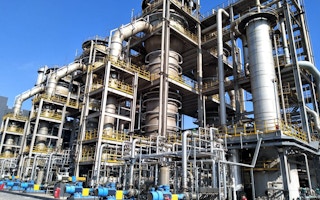Jennifer Holmgren, chief executive of carbon recycling firm LanzaTech, explained modestly how the Chicago-based startup had cut multi-million-dollar deals on four continents, including in China, aimed at helping curb climate change and air pollution.
At the Jingtang Steel Mill in Heibei province, the company uses bacteria to convert waste gases into ethanol for use in cleaner fuel, capturing carbon so that it is not released into the atmosphere as planet-warming carbon dioxide (CO2).
“It’s just like using sugar fermentation—like you do making beer,” said Holmgren. “The chemistry takes a couple of seconds.”
Like her, scores of entrepreneurs have been wracking their brains to move beyond the most common way to reuse waste CO2—pumping it into the ground to extract oil—and deploy it instead to make more planet-friendly materials.
Keeping CO2 out of the atmosphere via carbon capture and storage (CCS) is viewed by many scientists as necessary to limit global warming to the lower target of 1.5 degrees Celsius (2.7F) set in the 2015 Paris Agreement to tackle climate change.
“
Many early-stage tech investors don’t see energy and climate tech as ‘cool’ or carrying cachet, and we need to change that perception.
Matt Rogers, Angel Investor
Today CO2 captured from industrial facilities is mostly injected into ageing oil fields to maximize their output in a process known as enhanced oil recovery (EOR), where it is permanently stored away.
Fourteen out of 18 large-scale facilities worldwide that capture carbon dioxide supply it to EOR operations, data from the Global CCS Institute shows.
For some climate-conscious business people, that poses a conundrum.
”(With EOR) you know you’re generating an obvious new source of CO2 by using those fossil fuels,” said Marcius Extavour, who heads a competition, sponsored by NRG Energy and Canada’s Oil Sands Innovation Alliance, to develop technologies that can build valuable products with CO2 emissions.
The $20-million Carbon XPRIZE, launched in 2015, has been slimmed down to ten companies chasing a remaining $15 million in awards. Their inventions seek to turn the heat-trapping gas into bricks, carbon fiber and stronger cement, among other things.
Converting CO2 into new materials has been a niche industry so far—making fertilisers, methanol and baking soda, for instance, said Extavour.
“But because of the climate imperative, there’s renewed interest,” he added.
At a meeting on the nascent technique of CCS outside Jackson, Wyoming, last week, Holmgren said she hoped her company’s strides would “enable a new carbon economy”.
“I’m here to ask you to help the next guy that comes along,” she told the gathering.
Her words resonated with Gordon Skene, executive vice president of startup Phytonix, a Canadian company that has also engineered a bacteria that eats up CO2. It generates butanol, which goes into everyday products from perfume to paint.
Phytonix is trying to raise $3 million to go commercial. “It takes a lot of time and effort to explain the potential of the technology,” said Skene.
At Illinois Clean Fuels, Stephen Johnson, one of two-full time employees, said he was “on year 13 of sleepless nights” to launch a plant that will produce jet fuel from municipal garbage—and bury underground the CO2 it emits.
Manufacturing with CO2
With captured CO2 most sought after by oil operations, a nationwide network of pipelines more than 4,500 miles (7,240 km) long carries it to wells, according to a 2017 study by the Great Plains Institute.
But pipelines could also one day be plugged into manufacturing hubs that use recycled CO2 to make chemicals and building materials—if those industries really take off, said Richard Middleton with the Los Alamos National Laboratory.
Middleton is one of a group of scientists mapping an expansive grid of pipelines that, if built out, would maximise the amount of CO2 taken from sources like energy plants and heavy industry to sites where demand is highest.
Technologies like injecting and trapping CO2 in concrete is one market that could consume its fair share of the greenhouse gas in future, he said.
CarbonCure Technologies, a Canadian company competing in the Carbon XPRIZE, has developed such a system.
“But it’s a scale issue,” said Middleton, as ventures like this are still relatively small.
In industrial sectors that are likely here to stay, such as concrete manufacturing, removing CO2 will be key to tackling climate change, said Rebecca Dell, a strategist at the ClimateWorks Foundation.
Industry generates more than a third of greenhouse gas emissions worldwide, and its emissions—dominated by the manufacture of steel, cement and chemicals—are increasing at twice the global rate, she said.
“Emissions from the industrial sector are too high and so we… need to reduce them,” said Dell. “Industrial (carbon capture) is not the only way we’re going to do that, but it is a critical pathway.”
Pipedream to pipeline
Setting up infrastructure like CO2 pipelines as a way to combat climate change may, however, clash with ground-level politics, said Jason Grumet, president of the Bipartisan Policy Center, a Washington-based think tank.
Fierce opposition by environmental groups to natural gas pipeline projects like the Northeast Supply Enhancement, which was stopped earlier this month, is a hint of things to come, he said.
“I’ve never met someone who says ‘I’m just delighted that we’re going to build a pipeline near my community’,” he said.
Addressing the concerns of people living above underground CO2 storage sites will also be crucial, he added.
A 2018 study published in the journal Nature Communications concluded that “well-regulated” storage was “secure” overall but scientists were uncertain how CO2 behaved underground in the long term.
Meanwhile, convincing deep-pocketed investors is another work in progress, said Matt Rogers, a Silicon Valley-based angel investor who has put money into carbon-capture ventures.
“Many early-stage tech investors don’t see energy and climate tech as ‘cool’ or carrying cachet, and we need to change that perception,” he said.
This story was published with permission from Thomson Reuters Foundation, the charitable arm of Thomson Reuters, that covers climate change, humanitarian news, women’s and LGBT+ rights, human trafficking and property rights. Visit http://news.trust.org/climate.








